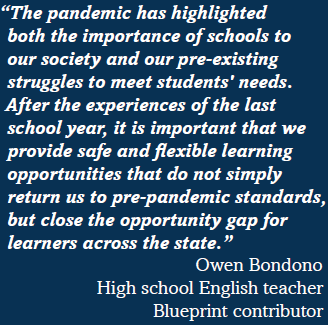Education Policy

The blueprint calls on state leaders to implement higher base funding for all schools with additional dollars for districts with higher populations of students who are at-risk, English language learners, or attending special education and career-technical classes.
Gov. Gretchen Whitmer has pressed for those changes every year since her election. In July, she signed a state K-12 education budget that brings historic investment in Michigan schools—more than $17 billion—and per-pupil funding at $8,700 that is equal across all districts for the first time since 1994.
“As I think about investments we need to make, certainly a number of things come to mind, but the education of our young people is the most important investment,” Whitmer said after signing the K-12 budget.
The budget includes $240 million to hire additional school counselors, nurses and social workers, and an increase in the Great Start Readiness Program enough to serve an additional 22,000 preschoolers from low-income families.
 However, the increased education spending does not address the reality that some districts have greater needs. Beyond that, one fiscal year budget cannot address all of the problems caused by decades of state disinvestment, a problem documented in numerous studies in recent years.
However, the increased education spending does not address the reality that some districts have greater needs. Beyond that, one fiscal year budget cannot address all of the problems caused by decades of state disinvestment, a problem documented in numerous studies in recent years.
A comprehensive study by the School Finance Research Collaborative tagged the base cost of educating a student in Michigan at $10,400, with more funding required in districts with greater needs.
However, between the state budget and $4 billion in federal COVID-relief funding, we are making progress with opportunities to fix aging infrastructure, improve access to technology and broadband internet, and address problems worsening the educator shortage, said MEA President Paula Herbart.
“These investments will show our communities what’s possible for our students when we fund their education appropriately, so we can make the case in the long run to fix our broken school funding system,” Herbart said.

Related stories:
Family and Community Engagement
School Climate and Post-Secondary Opportunities



